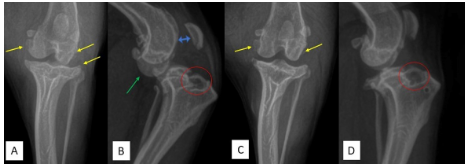Conservative and surgical approach to intra-articular chondrosarcoma in dogs
DOI:
https://doi.org/10.21708/avb.2023.17.4.11978Abstract
Chondrosarcoma (CSA) is a malignant mesenchymal neoplasm. Diagnosis is made through imaging and histological examinations. The prognosis is guarded, and treatment is predominantly surgical in most cases. The objective of this report is to describe an unusual case of intra-articular CSA associated with a cranial cruciate ligament (CrCL) rupture in a dog. A male mixed-breed canine patient, weighing 10.1 kg and nine years old, presented with a history of lameness in the left pelvic limb. After an orthopedic examination, knee radiography and synovial fluid analysis were performed. The results suggested arthritis, joint effusion, and CrCL injury. During surgery, a yellowish mass was identified in the infrapatellar fat pad region, adherent to the cranial portion of the tibial plateau. The mass was excised, and the knee was stabilized using the fabelo-tibial suture technique. Histologically, the tumor exhibited morphological characteristics of well-differentiated chondrosarcoma. The neoplastic cells expressed S100, did not express 1A4, Desmin, AE1AE3, and Osteocalcin, and showed partial expression of Ki67. Adjuvant chemotherapy with doxorubicin and cyclophosphamide was established. The patient had an excellent recovery and was followed up for 455 days postoperatively with no signs of recurrence. In conclusion, a less aggressive surgical approach with limb preservation is an alternative for the treatment of low-grade CSA and should be considered in patients with multiple orthopedic lesions that may compromise ambulation and quality of life.
Downloads

Downloads
Published
Issue
Section
License
Copyright (c) 2023 Acta Veterinaria Brasilica

This work is licensed under a Creative Commons Attribution 4.0 International License.
Autores que publicam na Acta Veterinaria Brasilica concordam com os seguintes termos: a) Autores mantém os direitos autorais e concedem à revista o direito de primeira publicação, com o trabalho simultaneamente licenciado sob a Licença Creative Commons Attribution que permite o compartilhamento do trabalho com reconhecimento da autoria e publicação inicial nesta revista. b) Autores têm autorização para assumir contratos adicionais separadamente, para distribuição não-exclusiva da versão do trabalho publicada nesta revista (ex.: publicar em repositório institucional ou como capítulo de livro), com reconhecimento de autoria e publicação inicial nesta revista. c) Autores têm permissão e são estimulados a publicar e distribuir seu trabalho online (ex.: em repositórios institucionais ou na sua página pessoal) a qualquer ponto antes ou durante o processo editorial, já que isso pode gerar alterações produtivas, bem como aumentar o impacto e a citação do trabalho publicado (Veja O Efeito do Acesso Livre).


 Esta obra está licenciada com uma Licença
Esta obra está licenciada com uma Licença 